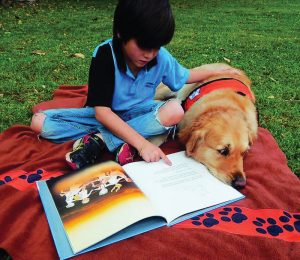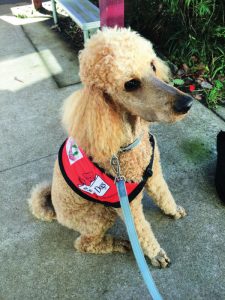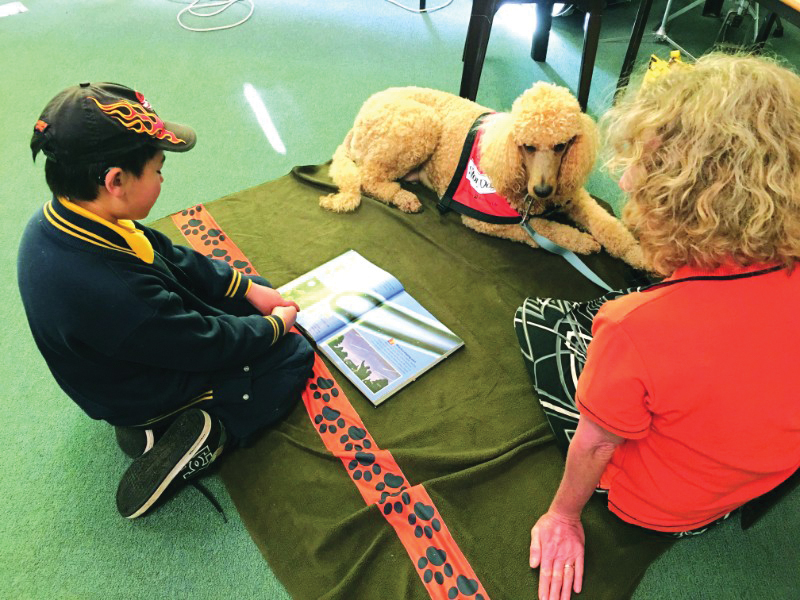Thanks to the help of our canine friends, many children and young people struggling to read are finding their happily ever after.
Pass a child a smartphone, a gaming console or an iPad and they’ll jump at the chance to play. Pass a child a book and many will screw up their noses, say reading is “boring” and “hard”, especially those struggling to make progress. The answer isn’t always in the classroom, as the Story Dogs program has discovered. Volunteers and their dogs are now helping close to 1000 children each week discover the joy of reading.
The Victorian pilot program started at Sandringham East Primary School, adding to the existing Story Dogs network that now spans Victoria, New South Wales, South Australia, Tasmania, Queensland and Western Australia. The children are mostly aged between seven and 10, and each week they sit and read with their dog and its owner. Through local sponsors donating $500 a year, the creative program is helping children relax, overcome their fear of reading and gain confidence, with the helping paw of a dog. This is a listener who won’t growl when they make a mistake and who won’t judge them if they’re slow to move through sentences or mispronounce a word. A dog simply sits and listens, often cuddled against their body, happy for a pat or a treat at the end of their time together.
The program was based on the successful American literacy program R.E.A.D (Reading Education Assistance Dogs), which began almost 20 years ago in Utah and now has 3000 therapy teams going strong.

Story Dogs coordinator for Melbourne, Suzanne McCourt, volunteers with her dog Barney at Sandringham East Primary School and says she’s witnessed dramatic improvements in her children’s reading since they started with the special doggy book time. Many make leaps and bounds through the literacy levels, with some beginning to read for their own enjoyment at home.
“There are dramatic, spectacular rises, children becoming really competent readers,” Suzanne says.
Her dog Barney was a boisterous foster dog that has mastered his naughty behaviour with good training and love. Now he’s helping children find focus for reading. Some children in the program have had trouble learning to read because of autism or ADHD (attention-deficit hyperactivity disorder), while others need the positive one-on-one connection with a dog due to emotional and social trauma suffered from situations such as losing a parent. What’s fascinating is that the benefits work both ways, with the dogs enjoying the experience as much as the kids. “I wasn’t prepared for how much the dogs love it,” Suzanne says. “When we get near the school, Barney starts sitting up and squeaking. And the minute his little coat is put on, he gets really excited.”
Louise and her Labradoodle, Sadie
When Louise Budd retired as a public servant working in taxes and accounting, she had time to devote to something she’s always been passionate about: dogs and children.
She and her Labradoodle Sadie visit four children in grade two at Laburnum Primary School. “I’d recently retired and I saw an ad for Story Dogs. It asked for someone who liked working with children, had a good dog and liked books, and that ticked all the boxes for me,” Louise says.
Louise and Sadie had a meet and greet with the local coordinator to see if they were both suited for the role. “You can have a lovely dog but if they’re a little too happy, they might just need to get a little older,” she says. “They need to check that the potential volunteer is prepared for the time commitment because the children come to rely on the dog coming.”
Sadie is 11 and she and Louise spend two hours each week at their school reading with the chosen children. “She’s very easy-going; her overriding characteristic is eager-to-please,” Louise says. “Sometimes she falls asleep and the child might notice and I say, ‘I’ll wake her up and maybe you can try that page again’.”
Louise says the benefit isn’t just the game of reading to an animal; it’s a chance to be affectionate with a friendly dog. “Some children get a lot out of the touch, rubbing behind the ear, or the game of reading to the dog, explaining the story like they’re the teacher. That’s really sweet,” she says. One of Louise’s children has a language disorder and was finding reading difficult to master in the group setting of the classroom. “I think she really benefited from the quiet time, the one-on-one time,” she says.
Another girl began the year with Louise and Sadie as very shy and reserved. “She made very little eye contact. Her reading wasn’t the biggest problem. It was her confidence. But she has a real affinity with animals and she opened up a lot through the year and she even spoke at the end-of-year assembly. She’s still quiet, but just to have that confidence makes such a difference. It was really thrilling to be part of that process,” Louise says.
One boy has a great sense of humour but often used it to cover for his insecurities about learning. “Several children often commented ‘you’re so lucky to read with Sadie’ so that’s a little bit of social cache for him,” Louise says.
That’s part of the positive influence of the Story Dogs program — that children struggling with learning or social skills suddenly have something special to help them and the experience involves the whole school.
“When we’re in the schoolyard, all the children come running. They’re very familiar with her. It’s a lovely opportunity to make the world a little bit more pet friendly,” Louise says. “And it’s a lovely feeling to be a special moment in these little people’s week.”
Making reading fun
Louise says the key is to show kids that reading doesn’t always have to be hard work and that it can be fun. “Teachers do a wonderful job and we wouldn’t pretend to take away from that, but so much of what they have to do is about assessing and watching the children’s progress,” she says. “What we’re really after is making it fun, that this reading business can be an enjoyable experience. One boy was very insecure about his reading. He had a great sense of humour so we ended up reading joke books. It’s still reading.”

Sheila Millar and her Standard Poodles Chia and Tikka visit Sassafras Primary School.
Daniel is 10 and in grade five but didn’t start speaking English until he was five. Half Egyptian and half Thai, he was speaking and reading Hebrew, which made it difficult to learn to
read English from left to right. Story Dogs has helped him make great progress and he often reads about some of his favourite topics including astronomy and science.
Natalie struggles with her focus and finds it difficult to stay on track with the book. She gets frustrated over the tricky words, but she’s keen to finish the 20-minute reading session so she can do dog tricks with Chia.
When she’s done, she gets a sticker and tries some training with Chia, who sits, drops, shakes hands and rolls over. She’s pretty pleased with herself that the dog is listening and responding to her commands. It gives her confidence that she’s good at something. Ellu has long blonde dreadlocks to his waist and has missed a lot of school. He lives on a one-hectare farm in Yarra Junction. When he arrived at Sassafras Primary School at the age of nine, he couldn’t read a jot. After a year of regular school and Story Dogs, he can get through a picture book. He’s slow, but Sheila is patient and encouraging and at the end, Ellu pats the dogs. He admits he doesn’t like reading much, but it’s definitely more fun with a dog.
Find out more at storydogs.org.au


Leave a Reply